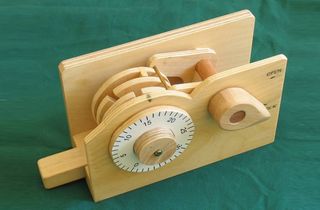
For more on the mechanics of a combination lock,
check out my Wooden combination lock model
Conventionally, a combination lock is opened by turning the dial two turns to the right, then to the first number, one turn left, and left to the second number, and then right again to the last number. This series of turns causes the rotors of the locks to have their notches aligned with each other (see wooden combination lock model)
However, there's nothing that prevents you from starting the combination counterclockwise instead of clockwise, and conventional combination locks can indeed be opened this way.
The left-right-left combination lock trick
Because the tabs on the rotors have non-zero thickness, slightly less than a full turn is needed to catch subsequent rotors. On account of this, to open a combination lock by turning left right left instead of right left right, the first number needs to be several numbers further to the right, and the second number needs to be several to the left.
The table below shows several locks that I worked out the left-right-left combination for. Note that for the Dudley lock, the left-right-left has the first number increase and the second number decreased -- exactly opposite of the other locks. This is because turning clockwise on a dudley increases numbers, but decreases them on the other locks.
The last number of the combinations doesn't change because the front most rotor
is directly coupled to the dial, so the direction of approach doesn't change its position
with respect to the dial.
| Lock type | | Difference RLR to LRL
| Dudley | Right-left-right: | 30 - 14 - 47
| First number increases by 14; | second number decreased by 10 Left-right-left: | 44 - 10 - 47
| Master | Right-left-right: | 15 - 17 - 31
| First number decreased by 7; | second number increased by 1 Left-right-left: | 8 - 18 - 31
| Dollar store | lock 1 Right-left-right: | 5 - 26 - 7
| First number decreased by 7; | second number increased by 2 Left-Right-left: | 38 - 28 - 7
| Dollar store | lock 2 Right-left-right: | 27 - 3 - 24
| First number decreased by 8; | second number increased by 4 Left-Right-left: | 19 - 7 - 24
| | |||||||||||||
I was hoping that the relationship for different locks of the same make would be the same, but it appears that at least for the two dollar store locks that I tried, the difference for the left-right-left combination is not quite identical.
The differences between left-right-left and right-left-right combinations are similar for the master lock and its knockoffs. So a best first try would be to apply the differences from the table above to your combination and try each one to see if any one of them opens the lock going left-right-left. Don't forget to turn the lock a full turn clockwise after the first number - it sounds silly, but I forgot to to do this often.
You can verify that the second number for left-right-left is correct doing the following set of turns on the lock: Two turns right, to the first number. Then turn one and three quarter turns to the left, and then right (by three quarters of a turn) to what you believe is the middle number for left-right-left, and then reverse direction to the left to the final number. If this opens the lock, you have found the middle number for the left-right-left combination.

For more on the mechanics of a combination lock,
check out my
Wooden combination lock model